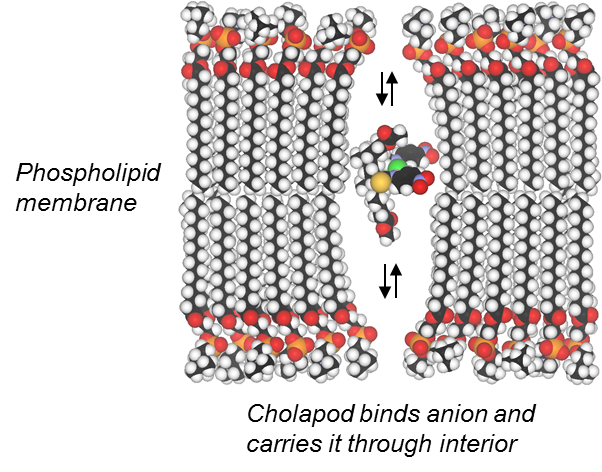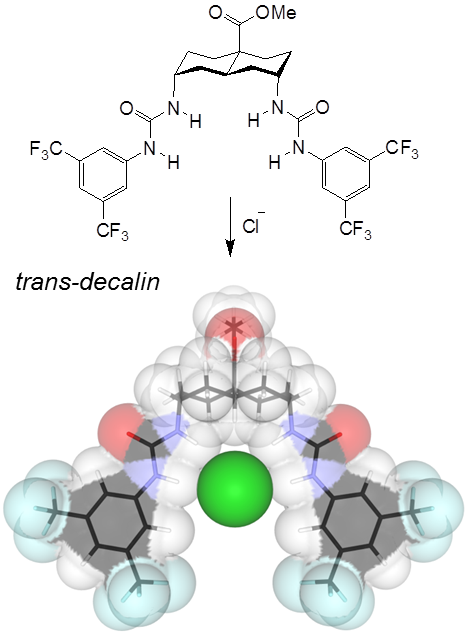The study of anion recognition has grown into one of the major areas of supramolecular chemistry. We are especially interested in electroneutral, lipophilic molecules which can reside in cell membranes, and which bind anions (e.g. Cl–) strongly enough to extract them from aqueous solution. These can then act as carriers, transporting the anions across the membranes. Interestingly, no molecules of this type have been found in nature, in strong contrast to the cation-transporting ionophore antibiotics (e.g. Valinomycin). It is possible that anion transporters might reveal new types of biological activity. Alternatively, if they do not show disruptive effects, they may be helpful to patients with missing transport systems. This is an important medical issue – several genetic diseases involve malfunctioning anion transport, the most notable being cystic fibrosis (CF).

 We have created a range of lipophilic anion receptors by exploiting a natural starting material, the steroid cholic acid. In particular, we have converted cholic acid into a range of “cholapods”, furnished with legs which contain powerful H-bond donors. These molecules are capable of binding anions in non-polar solvents with very high affinities. For example, the one illustrated shows an affinity (Ka) of 1011 M-1 to tetraethylammonium chloride in chloroform. It turns out that they do have the combination of properties required to act as anion carriers. Indeed, they can be very active – we can detect chloride transport though membranes which contain just one cholapod molecule for every 250,000 phospholipids.
We have created a range of lipophilic anion receptors by exploiting a natural starting material, the steroid cholic acid. In particular, we have converted cholic acid into a range of “cholapods”, furnished with legs which contain powerful H-bond donors. These molecules are capable of binding anions in non-polar solvents with very high affinities. For example, the one illustrated shows an affinity (Ka) of 1011 M-1 to tetraethylammonium chloride in chloroform. It turns out that they do have the combination of properties required to act as anion carriers. Indeed, they can be very active – we can detect chloride transport though membranes which contain just one cholapod molecule for every 250,000 phospholipids.

More recently we have investigated structures which  are inspired by the cholapods but not actually derived from steroids. These trans-decalins can be equally effective, but are smaller and more “drug-like”. We believe these molecules have promise as tools for biophysical research, and possibly even for use in patients. In current research we are focusing especially on testing both steroid- and trans-decalin-based transporters in biological systems, in collaboration with the group of David Sheppard in the University of Bristol School of Physiology and Pharmacology. We have also joined forces with Prof. Phil Gale of the University of Southampton. Together we hope to transform anion transporters from academic novelties into molecules of real medical significance.
are inspired by the cholapods but not actually derived from steroids. These trans-decalins can be equally effective, but are smaller and more “drug-like”. We believe these molecules have promise as tools for biophysical research, and possibly even for use in patients. In current research we are focusing especially on testing both steroid- and trans-decalin-based transporters in biological systems, in collaboration with the group of David Sheppard in the University of Bristol School of Physiology and Pharmacology. We have also joined forces with Prof. Phil Gale of the University of Southampton. Together we hope to transform anion transporters from academic novelties into molecules of real medical significance.
For summaries of this work see:
- H. Valkenier, A. P. Davis, Acc Chem Res.,2013, in press
- P. R. Brotherhood, A. P. Davis, Chem. Soc. Rev. 2010, 39, 3633-3647
- A. P. Davis, D. N. Sheppard, B. D. Smith, Chem. Soc. Rev. 2007, 36, 348-357